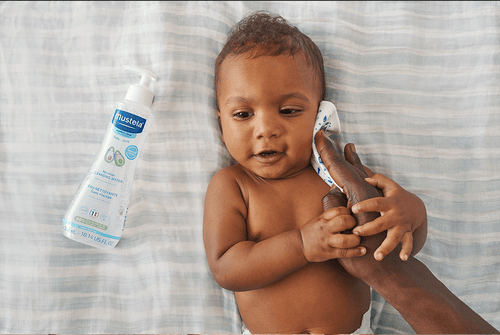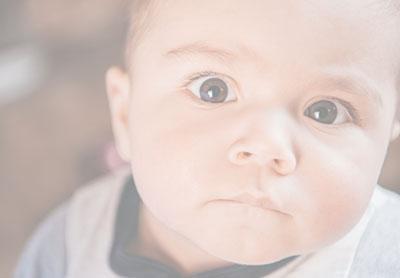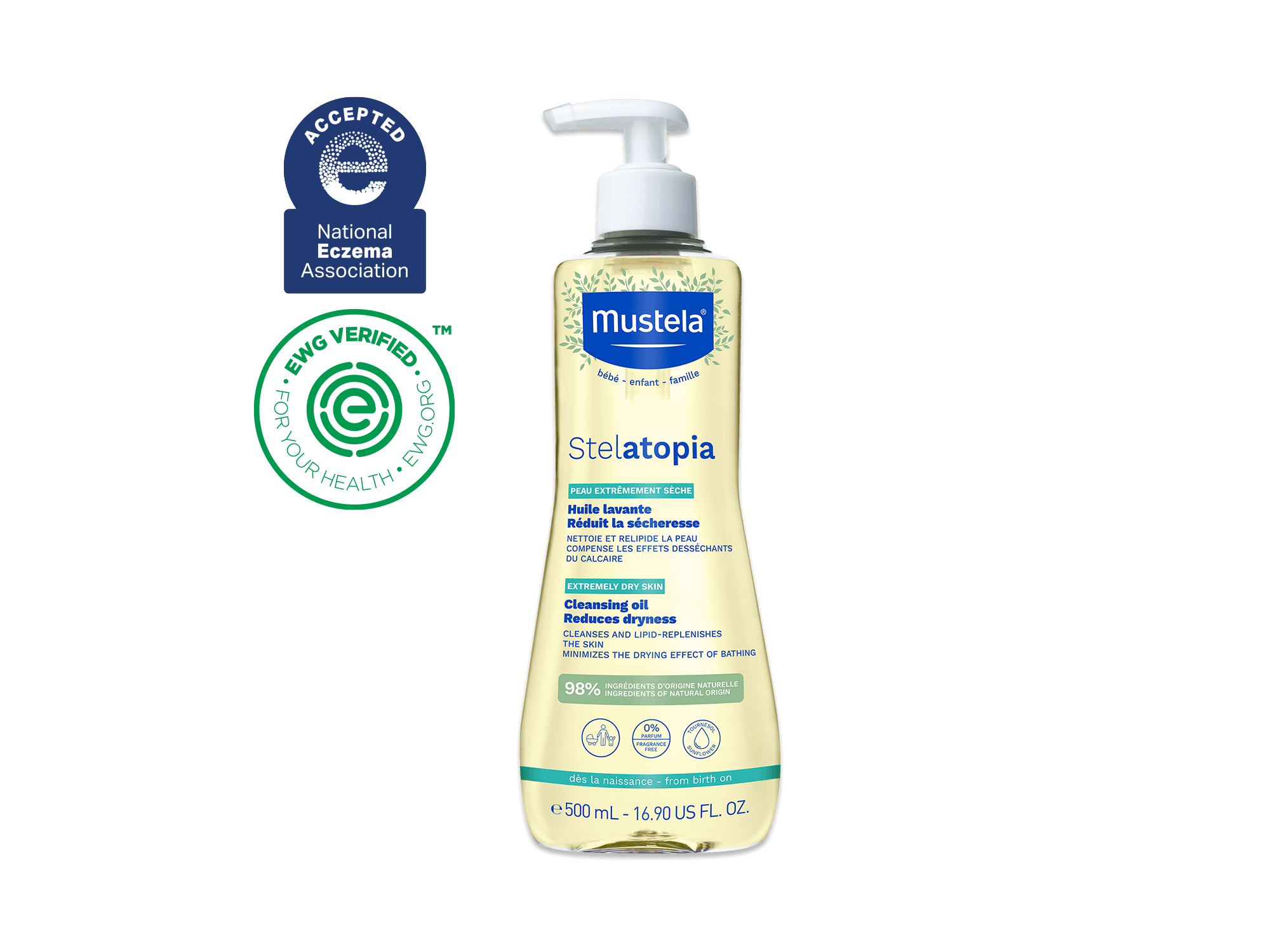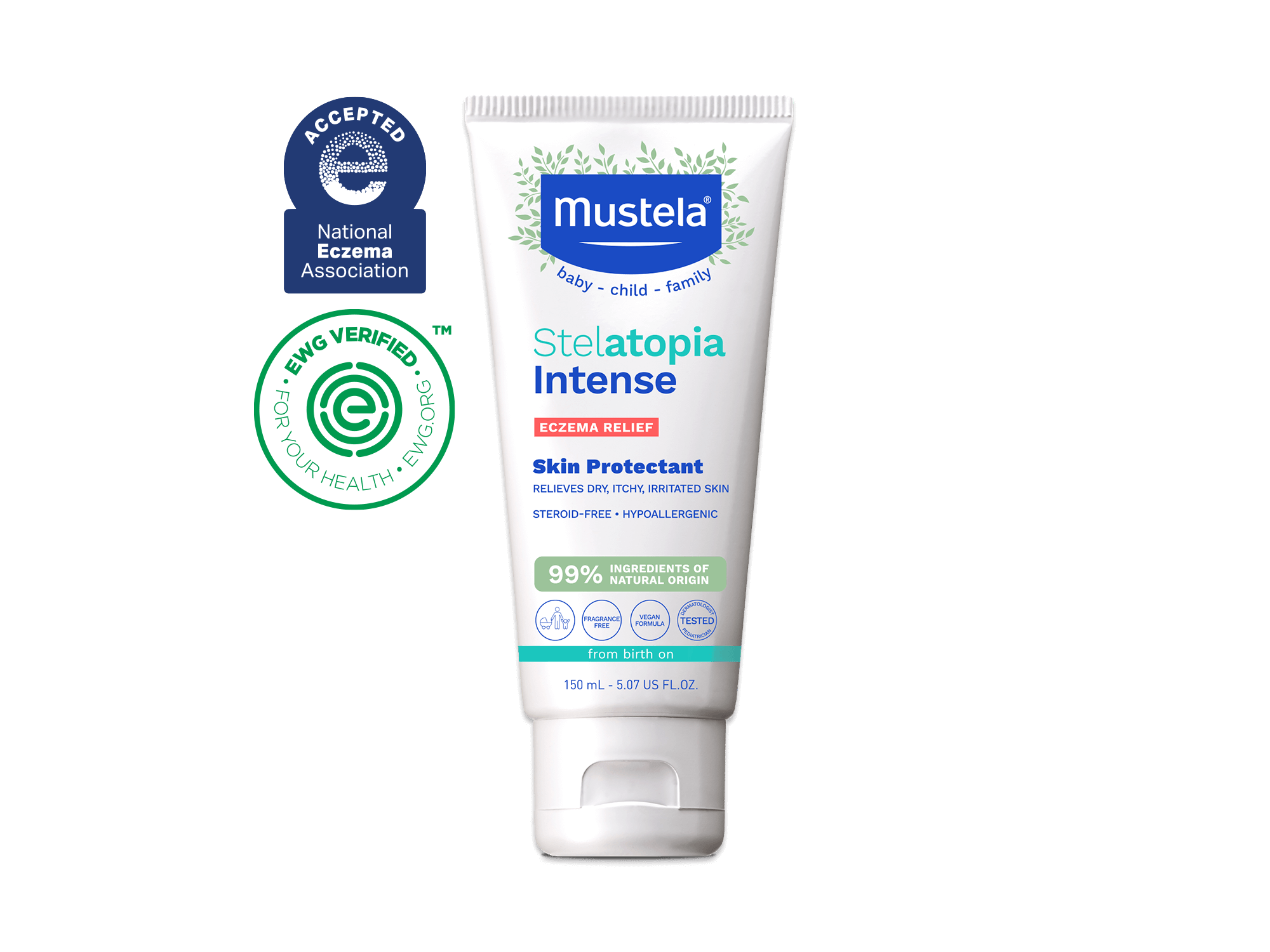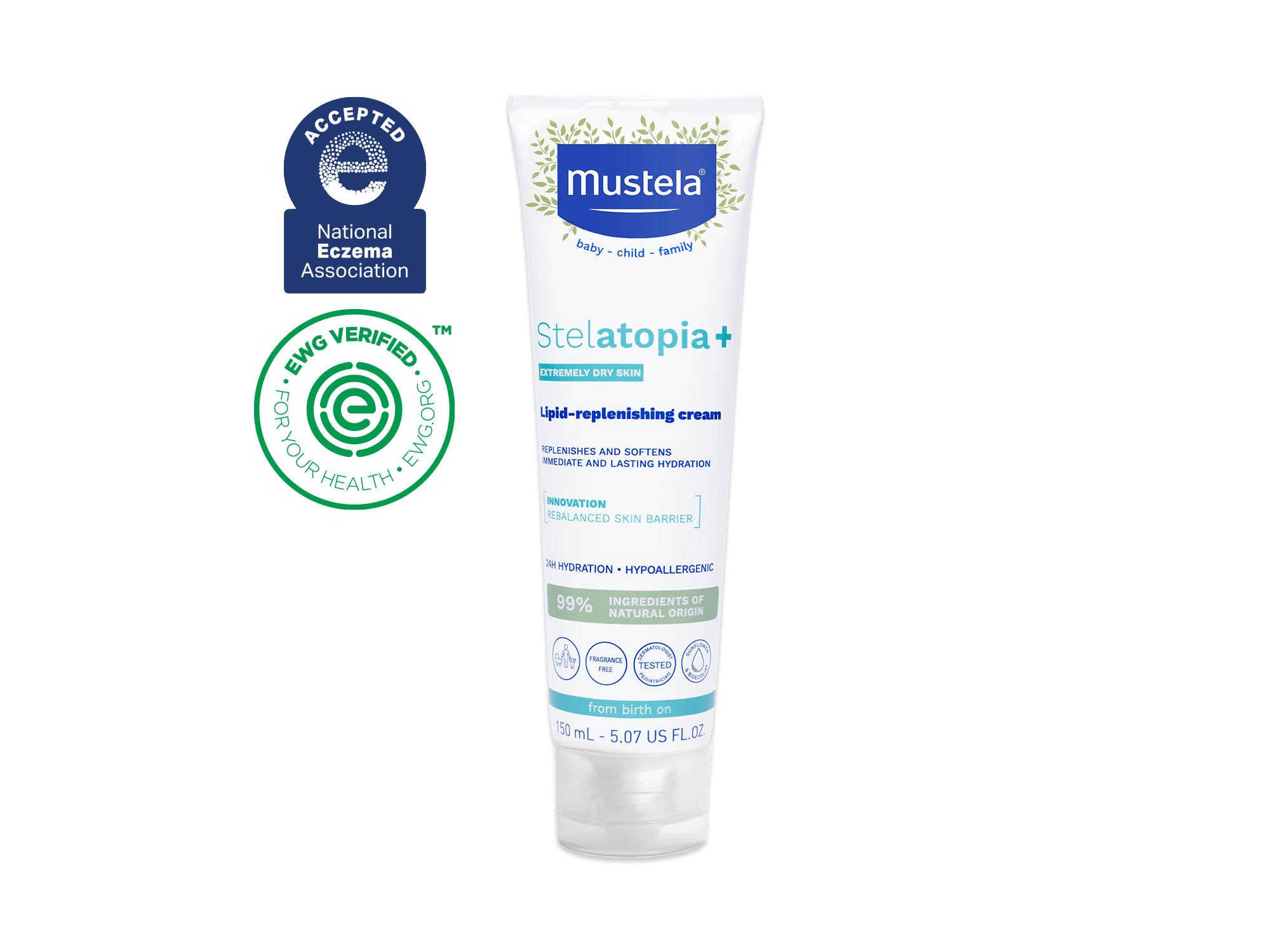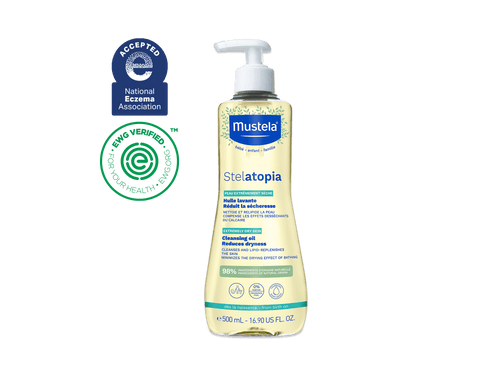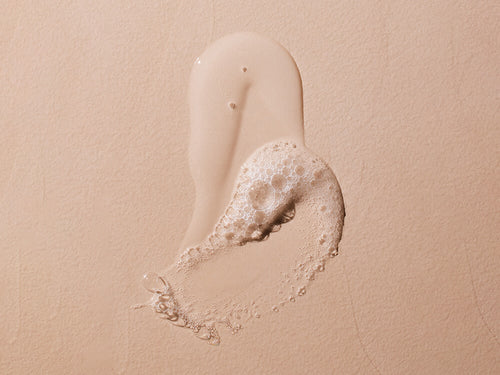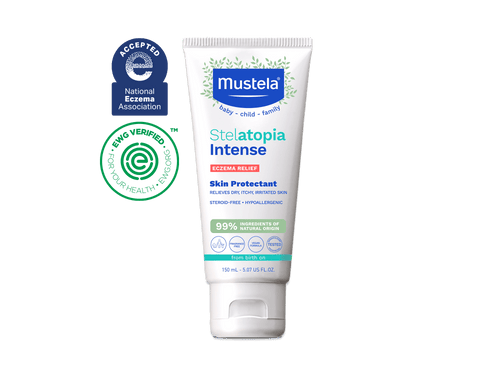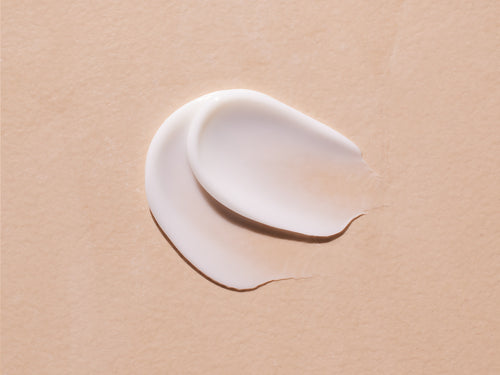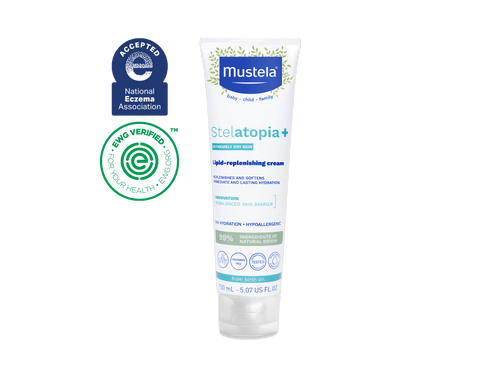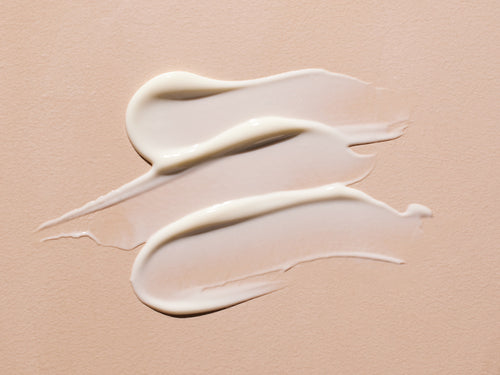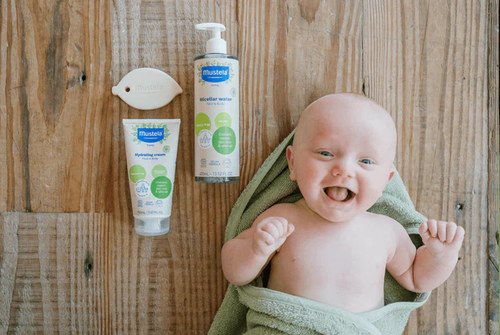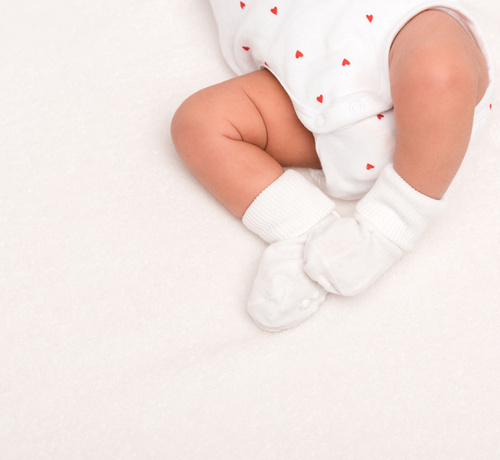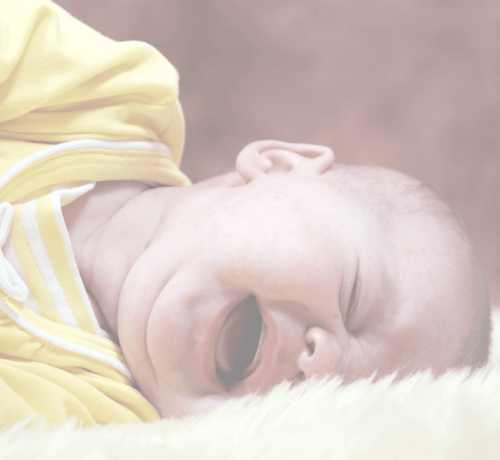Does baby eczema go away? This comprehensive guide will help you answer that question.
You’ll also find plenty of information about this common skin condition including what causes it, what treatment options are available, and whether or not babies can outgrow it over time.
Table Of Contents
- What Is Eczema?
- What Causes Baby Eczema (Atopic Dermatitis)?
- Can Baby Eczema (Atopic Dermatitis) Be Cured?
- Can Your Baby’s Eczema (Atopic Dermatitis) Improve?
- Does Baby Eczema Go Away On Its Own?
- What Factors Affect Eczema (Atopic Dermatitis) Flare-Ups?
- When Will Eczema (Atopic Dermatitis) First Appear?
- Caring For Eczema-Prone Skin
- Can You Prevent Eczema?
What Is Eczema?

When you finally identify those dry, red, itchy patches on your little one’s skin as baby eczema or atopic dermatitis, a lot of your worry and stress goes away.
That’s because this form of eczema is very common (it affects one in every five children, ref: gosh.nhs.uk) and can be very easily treated without a prescription in most cases.
But what exactly is eczema? It’s a chronic skin condition that usually develops in early childhood and is characterized by dry, inflamed, and itchy skin.
Unfortunately, despite the relief you may feel to finally have a diagnosis, knowing your baby has eczema (atopic dermatitis) can raise even more questions, like:
- What causes baby eczema?
- Is baby eczema contagious?
- Can eczema (atopic dermatitis) be cured?
- Can your baby’s eczema (atopic dermatitis) improve?
- Does baby eczema go away on its own?
- What factors affect eczema (atopic dermatitis) flare-ups?
- When will eczema (atopic dermatitis) first appear?
- What is the best treatment for this skin condition?
- Can you prevent eczema (atopic dermatitis)?
Mustela is here to help. This article will answer those questions (and more) to help you see why, if you treat it correctly, eczema (atopic dermatitis) isn’t anything to worry about.
What Causes Baby Eczema (Atopic Dermatitis)?
If your little one is suffering from baby eczema, you’re probably wondering where it comes from. While environmental factors and your baby’s immune system probably have something to do with eczema, the short answer is that eczema is a genetic condition.
That’s right — it’s passed on from parents to children. If you or your partner have eczema or are prone to dry skin, you might pass it on to your little one. Your child is also more likely to develop eczema if either of you has other atopic conditions, such as:
- Food allergies
- Asthma
- Hay fever
But don’t be discouraged. Not everyone who is genetically predisposed to eczema will develop the condition. A specific trigger often causes symptoms to flare.
When it comes to dealing with eczema, preventing flare-ups is the name of the game. So, realizing early on that your baby might develop eczema allows you to take action to reduce the risk of flare-ups.
We’ll look at some common triggers in a moment, but first, let’s address a common eczema myth.
Is Baby Eczema Contagious?
Baby eczema isn’t contagious. Your little one isn’t going to give it to their friends or other family members. Bacteria or viruses do not cause it, and it’s not airborne or spread by touch.
Eczema Triggers

While genetics is the root cause of eczema-prone skin, various factors can lead to flare-ups (which appear as red, dry, rough, and itchy skin). This is when you really notice that your baby suffers from eczema.
Every baby’s delicate skin is sensitive to different things, so you’ll need to figure out what triggers your baby’s eczema specifically.
For many infants, flare-ups can be caused by:
- Dry skin (think extra-dry skin thanks to winter weather or dry climates)
- Irritants like dust, air pollution, soap, lotion, laundry detergent, shampoo, and cleaning products
- Heat (in the summer or from too many layers of clothes)
- Diet (your baby’s diet or yours if you’re breastfeeding)
- Poor gut health
- Allergens (like pet dander, mold, or pollen)
- Stress
Now that you know what causes eczema, you’re probably wondering if this frustrating condition can be cured.
Can Baby Eczema (Atopic Dermatitis) Be Cured?

The simple answer is no; eczema (atopic dermatitis) cannot be cured. This form of eczema is encoded in your baby’s genetic makeup and can never be removed completely. The red, itchy patches that flare up on your baby’s skin are caused by a combination of:
- Atopic-prone (dry) skin
- A reaction to some allergen(s) in your baby’s environment
As bad as that may sound, eczema does not pose a threat to your baby’s long-term health or happiness. Because eczema (atopic dermatitis) is essentially an allergy like the hay fever that most adults suffer from, that means there is relief that can improve your baby’s comfort level and temperament.
Unlike you, your baby can’t take an allergy pill. Instead, they just need a little TLC in the form of a daily application of an emollient cream. When your baby’s body reacts to the allergens, it’s with inflamed, itchy skin instead of with sneezing and a runny nose.
When put that way, it doesn’t seem like such a major thing anymore, does it?
Can Your Baby’s Eczema (Atopic Dermatitis) Improve?
Yes! Your baby’s eczema (atopic dermatitis) will get better, and will even disappear completely if treated properly. Again, that doesn’t mean your baby is cured.
Your child will always be prone to eczema (atopic dermatitis) outbreaks, even into adulthood, because of their atopic-prone skin. And those flare-ups will come and go from time to time depending on their environment and how much care is put into preventing them.
Does Baby Eczema Go Away On Its Own?

Until a few years ago, the conventional teaching about eczema was that most children outgrow the condition by age 10. Unfortunately, ongoing research no longer backs up that statement.
While many children will see their symptoms improve and may be able to live their lives as though they don’t have eczema, others will continue to experience flare-ups in adulthood. In addition, some children who outgrew eczema will experience a relapse later in life.
When it returns, the eczema may not be the same. It could be more or less severe, be brought on by new triggers, or occur in different body parts.
This phenomenon makes it harder for doctors to distinguish between a new case of adult-onset eczema and a relapse of a childhood condition, especially if the patient’s symptoms disappeared in early childhood.
As scientists conduct more and more studies, they’re learning that many people with seemingly adult-onset eczema had the condition in childhood. It was just in remission for years.
They’re still trying to figure out why. The research about filaggrin, a natural protein recently linked to the skin barrier, is fascinating. Future studies are required, but the current theory is that this protein plays a leading role in the development of eczema.
And who knows — once scientists discover a specific cause, a cure may be within reach. That’s something to celebrate!
But for now, know that baby eczema doesn’t go away on its own. If left untreated, it can worsen and cause lifelong discomfort and skin damage.
To help prevent that, you’ll need to prioritize caring for your baby’s skin.
But before we talk about treatment options, it’s important to understand what factors can lead to an eczema (atopic dermatitis) flare-up, and when those flare-ups can first appear.
What Factors Affect Eczema (Atopic Dermatitis) Flare-Ups?

One of the major factors that can affect eczema (atopic dermatitis) flare-ups is your baby’s skin itself. The genetic condition mentioned earlier can result in what’s called atopic-prone skin. This is really just a fancy term for skin that is dry and easily irritated.
On a more technical note, atopic-prone skin is characterized by “holes” in the protective layer of water and oil (hydrolipidic barrier) on your baby’s skin. Those holes allow moisture to escape and allergens to get in.
This combination of dry skin and irritation leads to flare-ups when conditions are right. What makes the conditions “just right”?
It all depends on the sensitivity of your child’s skin. If they suffer from extreme atopic-prone skin, every little thing may cause a flare-up. If they suffer from mild atopic-prone skin, only a very specific set of circumstances may cause a flare-up.
And those “just right” conditions also depend on your child’s environment and activities. They may be allergic to certain fabrics, the pet dander from your dog, or even something they ate.
That’s why it’s so important to consult a physician to help you identify the triggers that set off your baby’s eczema (atopic dermatitis). They may do allergy testing or ask you to track possible triggers in a skin journal.
Another major factor that affects eczema (atopic dermatitis) flare-ups is regular daily care. As you’ll see in the care and prevention section below, the diligence with which you treat your baby’s skin goes a long way toward minimizing the itchiness and swelling of flare-ups and even keeping them at bay.
Now that we know what can lead to an eczema (atopic dermatitis) flare-up, let’s discuss when those flare-ups may first appear.
When Will Eczema (Atopic Dermatitis) First Appear?
The first signs of atopic-prone (dry) skin can appear at birth. Dry, even scaly, patches of skin can indicate that your baby may be suffering from an eczema (atopic dermatitis) flare-up.
Those flare-ups usually begin to occur when your baby is two months old, although they can appear even earlier. Flare-ups are nothing to get worked up or worried about. They will not cause any lasting damage to your baby’s skin unless they are left untreated and get infected.

From two months to one year of age, flare-ups will mostly appear on the chubby areas of your baby’s body, such as their:
- Chin
- Cheeks
- Arms
- Belly
- Calves
- Feet
Keep in mind that stress can also set off an eczema (atopic dermatitis) flare-up. So even if you treat your baby’s skin daily and haven’t seen an outbreak in months, when they start teething around six months, a flare-up may appear despite your best efforts.
This, in itself, is nothing to worry about. It doesn’t mean that the condition has worsened or that you did something wrong. It merely means that the stress of teething caused an extreme reaction on your little one’s skin.
Keep up the treatment as we outline below, and when that initial teething pain goes away, so too will their eczema (atopic dermatitis) flare-up.
After the age of one, eczema (atopic dermatitis) may appear less on the chubby areas of your baby’s skin and more on the skin folds, such as elbows, neck, back of the knees, wrists, and even behind the ears (a particularly atopic-prone part of the body).
By the age of three or four, flare-ups will continue to appear on skin folds but will also appear on hands and around the mouth and eyes. By five or six, eczema (atopic dermatitis) usually goes away. This is thanks to a combination of treatment and your child’s development.
Even after the symptoms disappear, continue to treat your child just like you did before to minimize flare-ups from occurring. Remember: their condition isn’t really gone; it’s just in remission.
A Note About Facial Eczema
Many parents will panic when their baby’s eczema flares up on their face. They’re nervous because the red bumps have appeared in such a prominent place, and they fear that their baby will suffer this way for the rest of their life.
You might also worry that your little one will have scars. Or fast-forward several years and imagine their prom pictures, with their faces covered in noticeable red patches. These thoughts can leave you overwhelmed and hopeless.
If you feel like this at the first signs of your baby’s eczema face, take a deep breath and try to relax. Let’s look at some essential truths.
First of all, it’s a normal reaction to be concerned about your baby’s well-being and what their condition could mean for the future. You love them and want what’s best for them. These are signs that you’re doing a fantastic job at parenting.
Second, as we mentioned above, eczema — even facial eczema — won’t cause any lasting damage as long as it’s treated properly.
One of the best ways to treat facial eczema is with a special cream designed exactly for that, such as Mustela’s Stelatopia Emollient Face Cream.
Speaking of treating eczema, let’s talk about the care and prevention of baby eczema so you can get your little one feeling good as soon as possible!

Caring For Eczema-Prone Skin
Understanding the causes and contributing factors of eczema helps you understand how to keep it at bay. But at the end of the day what you really need is an action plan! You want steps to take to care for your baby’s eczema.
Below, we’ve listed several ways to soothe your baby’s eczema-prone skin. Proper care will reduce itchiness when your baby is dealing with a flare-up and also help prevent future flare-ups.
At Mustela, we love natural and eco-friendly solutions and we’ve listed a few in this article, but you can read more about natural eczema treatments for your tiny tot here. Without further ado, let’s jump in.
1) Identify The Allergen
Sometimes the cause of a flare-up can be hard to pinpoint, but do your best to identify any allergen that could have caused skin irritation. This could be dust, harsh soap, pet dander, mold spores, a certain food, and a host of other things.
Ask your pediatrician if eliminating certain foods would improve your baby’s eczema. And if you’ve identified an allergen (food or otherwise), remove it from your baby’s environment if you can.
This might mean changing your breastfeeding diet, switching from carpet to hardwood floors, or finding a new home for your constantly shedding, long-haired cat. You may also need to try new fragrance-free lotions and soaps.
2) Remove Other Triggers
Allergies aren’t the only factors that can worsen eczema symptoms. Other environmental factors are often involved, which we listed in the Eczema Triggers section above.
Once you’ve identified your baby’s triggers, here are some practical ideas for avoiding them:
- Put a humidifier in the nursery to add moisture to the air
- Buy new clothes that aren’t tight or made from irritating materials
- Wash your baby’s bedding regularly (in gentle laundry detergent)
- Avoid exposure to smoke
- Don’t use scented candles
While you can’t put your baby in a protective bubble, you can make simple changes to protect them from many eczema triggers.
3) Keep Your Baby From Itching
Baby eczema is annoying and itchy. One of your jobs is to keep your little one from itching and scratching at their eczema — easier said than done!
To help, keep your baby’s fingernails cut short, and put mittens or socks on their hands so they can’t scratch (which just irritates their skin even more). Even if you only do this at night, it can make a difference.
4) Dress Your Baby In Natural Fabrics
Because clothing can irritate your little one's eczema-prone skin and cause a flare-up, be mindful of the materials you dress them in. Opt for cotton, linen, and silk, but avoid wool. Think natural, smooth, and comfortable fabrics.
To calm their skin and reduce itchiness overnight, try Mustela's Stelatopia Skin Soothing Pajamas, which deliver soothing moisture while your baby sleeps.

5) Avoid Tight Clothing
In addition to being careful about the fabric of your baby’s clothes, make sure their clothes aren’t too tight. Tight clothing can irritate your little one’s skin, trap heat near their body, and cause them to sweat — all of which can contribute to an eczema flare-up.
On cold days, dress your baby in several layers rather than tight, thick clothing. Take layers off as needed so your little one isn’t too hot or too cold.
Be mindful of when your baby approaches the end of a particular clothing size. It’s best to move them up a little too soon than to dress them in tight clothes.
6) Wash Clothes To Prevent Eczema
To care for and prevent baby eczema, reduce allergens and irritants when you do laundry. To do so, use a hypoallergenic laundry detergent and consider putting clothes through an extra rinse cycle in the washing machine to rinse off any residual allergens.
After, dry your baby’s clothes inside. As nice as it is to let onesies and tiny pants dry in the sun and breeze, allergens from the great outdoors could get on your baby’s clothes and then irritate their skin.
7) Use Calming Products
Think about all the products you use on or around your baby. Do they contain irritants or chemicals that could aggravate your baby’s eczema?
Consider switching to eczema-friendly products that will help, not harm, their sensitive skin. Cover all your bases, from clothing and laundry detergent all the way to diapers and diaper wipes.
Look for products that are:
- Fragrance-free
- Made with natural ingredients
- Free from harmful chemicals like parabens, phthalates, and phenoxyethanol
The National Eczema Association has a Seal of Acceptance that can help you find products for your little one. This seal shows that a specific product has undergone testing for sensitivity, irritation, and toxicity and meets the standards the association established.
8) Apply Sunscreen
For many babies, the sun’s rays can trigger eczema symptoms. Using sunscreen offers a layer of protection.
While you should not use sunscreen regularly on a newborn, it should become a staple in your skincare routine for babies over six months.
In addition, the following precautions can help keep your little one out of the sun:
- Stay in the shade
- Select loose, protective clothing
- Put on a wide-brimmed hat
- Use sunglasses
- Reapply sunscreen every two hours or immediately after swimming
9) Know When To Seek Medical Care
If your baby’s eczema isn’t getting better with home care, then it’s time to visit the doctor. They may prescribe a mild steroid cream for severe cases or refer you to a dermatologist or allergist to help develop a treatment plan.
10) Give Your Baby A Soothing Bath
Bath time can soothe your baby’s eczema and reduce itching if you do it right! Start with bathwater that’s not too hot and not too cold. If you have a bath thermometer, shoot for somewhere between 97 and 98.6 degrees.
Then add a bath oil to the water — like Mustela’s Stelatopia Bath Oil, which is specially formulated with sunflower oil, avocado oil, and chamomile extract to soothe, strengthen and soften the skin. It’s fragrance-free and great to use every day or during an eczema flare-up.
Next, wash your baby’s delicate skin with Stelatopia Cleansing Gel and lather their hair with Stelatopia Foam Shampoo.

Finally, don’t leave your little one in the bath for too long. As much fun as bath time can be, a long bath can dry out their skin, which is not what you want! When you get your baby out, you’ll want to apply a calming lotion right away, which brings us to our next point.
11) Apply Emollient After Bath Time (And Every Day!)
Don’t let your baby’s skin dry out after bath time. Reinforce their skin’s moisture barrier by applying Stelatopia Emollient Cream when you get them out of the tub.
In fact, the best method for treating and preventing eczema (atopic dermatitis) flare-ups is to apply an emollient product to your baby’s skin every day. We recommend Mustela’s Stelatopia+ Lipid Replenishing Cream or Stelatopia Emollient Face Cream for repeated application and Stelatopia Cleansing Gel for bath time.
These specially designed formulas are safe enough to start using the day your baby is born and powerful enough to use every day thereafter to prevent atopic-prone skin and eczema (atopic dermatitis) flare-ups.
Since emollients are so important for eczema care, let’s take a look at the best way to apply an emollient cream.
The Best Way To Apply An Emollient Cream
Even though an emollient cream is specially formulated for eczema-prone skin, the way you use it isn’t really any different than the way you use a regular cream. Simply apply the emollient product twice per day to your little one’s clean, dry skin while paying special attention to particularly dry areas.
Step #1
Wash your hands to remove any foreign substances like dirt, pollen, adult hand creams, and animal dander. Washing is also a great way to soften and warm your hands so that you don’t irritate your baby’s skin or give them a shock when you apply the emollient.
We recommend avoiding regular liquid or bar soaps and opting instead for a gentle, fragrance-free soap like Mustela’s Stelatopia Cleansing Gel. This will minimize the risk that you transfer an allergen to your little one’s skin.
Step #2
Remove your jewelry. As an adult, you probably don’t think about how rough and sharp jewelry can be because it doesn’t bother your mature skin. But to your little one’s eczema-prone skin, a small nick or rough edge can feel like a pinprick.
Your baby will wriggle and move while you’re rubbing their skin, so we suggest removing all jewelry from your fingers and wrists before applying an emollient product. This will ensure that nothing comes between you and your little one’s sensitive skin.
Step #3
Make sure your nails are trimmed. You don’t have to trim your nails every time you apply an emollient cream. That’s unnecessary.
You really just need to make sure they’re short enough (so they don’t poke or scratch your baby’s sensitive skin) and that there are no sharp points or jagged edges.
Step #4
Warm the emollient cream before applying it to your baby’s skin. Cold and heat can trigger an eczema flare-up just like dust, rough fabrics, and other irritants. You don’t want to accidentally cause an eczema flare-up while you’re trying to prevent them.
To warm the emollient cream, squirt a generous amount onto the palm of your hand. Then rub your palms together for about ten seconds (like you would if you were trying to warm them on a cold day).
You don’t have to apply the emollient to the backs of your hands like you would a regular hand cream, so resist the urge to rub in a circular motion.
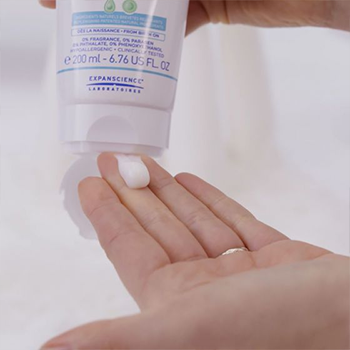
Additionally, before you dismiss this step as unnecessary, think about it this way. Most creams are stored at room temperature. Depending on the time of year and how cool or warm you like to keep your house, that can range anywhere from 65 to 80 degrees Fahrenheit.
Your baby’s normal skin temperature is 86 to 89 degrees Fahrenheit (about six degrees less than their core body temperature). So if you keep your house at 70 degrees Fahrenheit, the emollient cream will be at that temperature too.
Imagine applying a cream that is almost 20 degrees cooler than the temperature of your baby’s skin. That would come as quite a shock to your little one. You can keep your baby comfortable (and flare-up-free) by warming the emollient cream before applying it to their skin.
Step #5
Apply the warm emollient cream all over your baby’s body. Even if your baby’s eczema only flares up in certain areas (like their wrists or cheeks), it’s a good idea to apply the emollient everywhere. This helps strengthen the hydrolipidic layer on your baby’s skin.
Don’t forget especially flare-up-prone areas, like the creases behind your baby’s ears and in their elbows and knees.
Apply An Emollient Multiple Times A Day
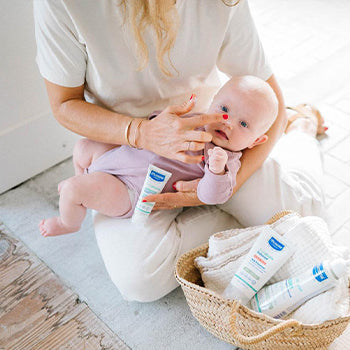
We recommend at least twice (morning and evening), but don’t be afraid to apply emollient cream three, four, five or more times per day if that’s what your baby needs to stay comfortable.
The gentle ingredients in Mustela’s Stelatopia+ Lipid Replenishing Cream — like Avocado Perseose and sunflower oil distillate — mitigate the drying effects of environmental conditions by enveloping your little one’s skin in a silky, hydrating barrier that protects, moisturizes, and soothes dry, itchy skin.
With repeated emollient use and as your baby’s skin begins to repair its hydrolipidic layer, the potential for flare-ups will decrease. That means you’ll eventually be able to reduce the number of emollient applications your baby needs to stay comfortable and avoid flare-ups.
But even if your baby’s symptoms disappear, don’t stop using emollient cream completely. They’ll be less likely to experience another flare-up if their skin stays moisturized, so rub it on at least once a day.
Can You Prevent Eczema?
Though the steps above can help reduce eczema symptoms and prevent future flare-ups, there’s no proven way to completely prevent your child from developing this condition.
However, if you know your little one is prone to eczema, the American Academy of Dermatology Association has a few insights that may help.
Breastfeeding Might Make A Difference
Though research is limited, breastfeeding may help reduce your baby’s chance of experiencing eczema symptoms, especially if you breastfeed for at least four to six months and don’t introduce solids until then.
Moisturizing Is Essential
Dry skin is a significant risk factor for an eczema flare. If you keep your little one’s skin moisturized from the get-go, they may never experience itchy, red patches.
It’s essential to pick a moisturizer that is baby-friendly and fragrance-free. Otherwise, you could inadvertently cause a flare-up.
A Dog Might Be Your Baby’s Best Friend

Early exposure to dogs has been linked to a lower risk of developing eczema. Some studies show that having a dog in the house before your baby turns one can reduce their risk of atopic dermatitis.
Of course, there are drawbacks to having a dog in the house. So don’t feel like you have to get one just for this reason!
After all, the research is limited, and other factors could have been at play. But if you’re already considering a pet and like dogs, it might not hurt.
Note: Unfortunately, the studies weren’t the same with cats. Those furry friends didn’t have the same effect.
There’s No Guarantee
While some methods may help reduce the risk of eczema, it’s important to remember that there is no guarantee.
Eczema is a complex condition that doesn’t affect everyone in the same way.
Sometimes, despite all your efforts, your child may still experience a flare-up. It doesn’t mean you’re a bad parent or that something went wrong. It’s just the way their body reacts to their environment.
Reduce Eczema Flare-Ups For A Happy, Healthy Baby

Does baby eczema go away? Not completely. Remember, fewer flare-ups doesn’t mean that your little one has been cured. It just means that you’ve eliminated the irritants that cause flare-ups and that their sensitive skin has gotten stronger.
But until that happens, continue to keep your little one happy and healthy. For babies with eczema-prone skin, that means exposing them to fewer irritants and applying plenty of emollient cream.
Keep Stelatopia+ Lipid Replenishing Cream in your diaper bag, in the bathroom, and even at grandma and grandpa’s so you’ll always have it on hand. Your baby’s skin will thank you for it!

